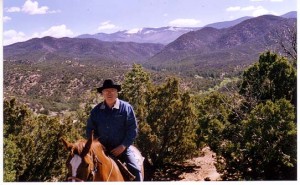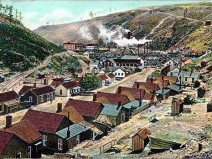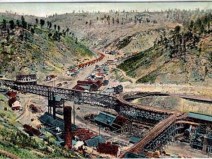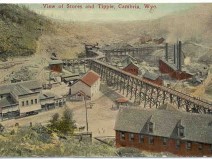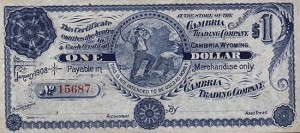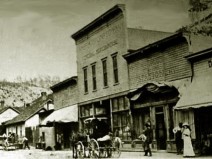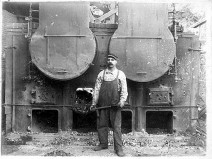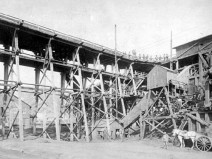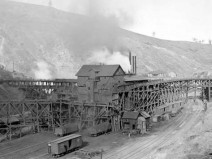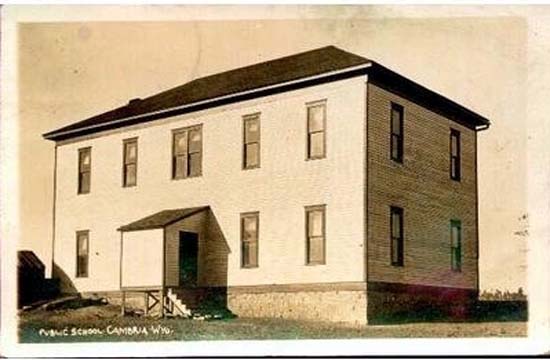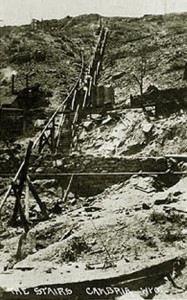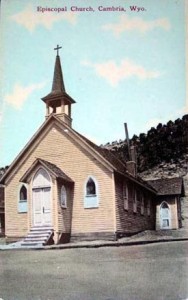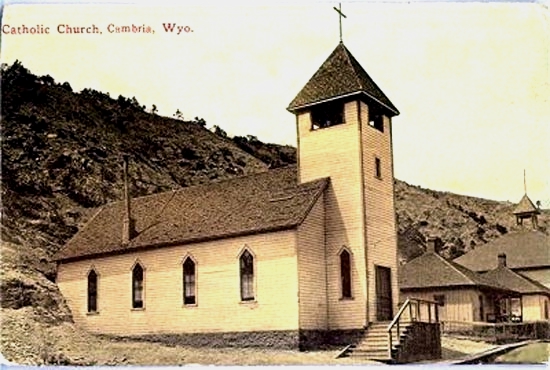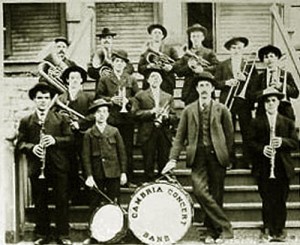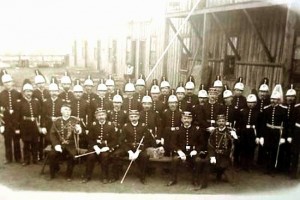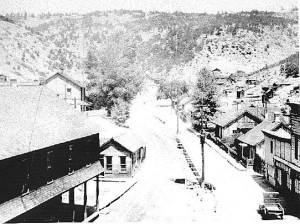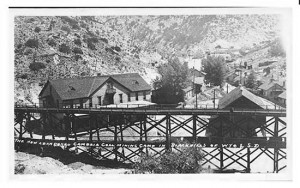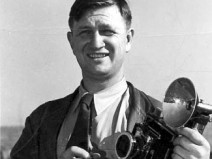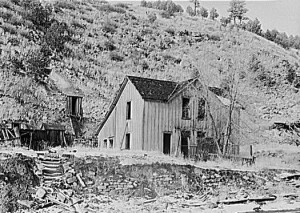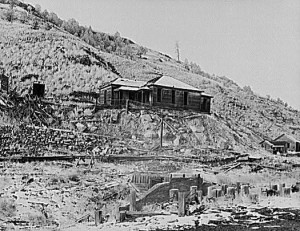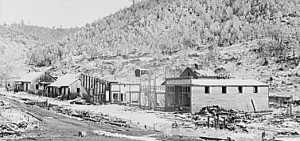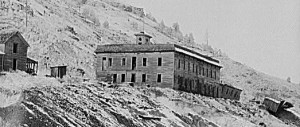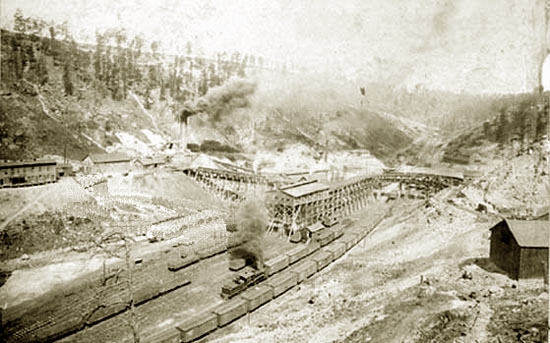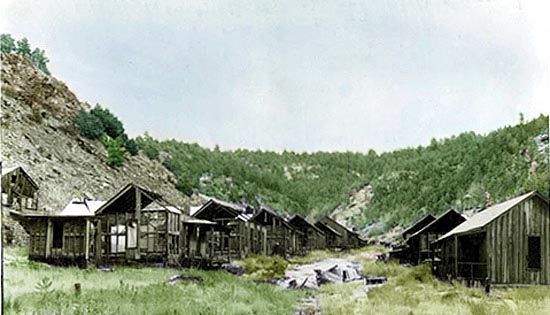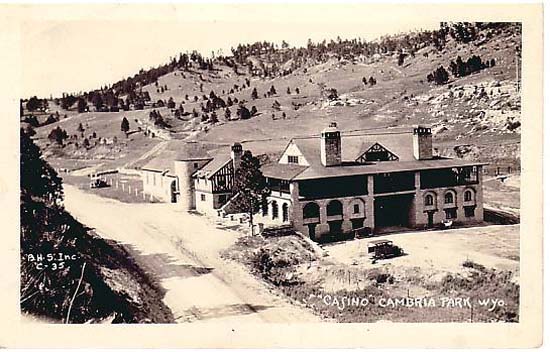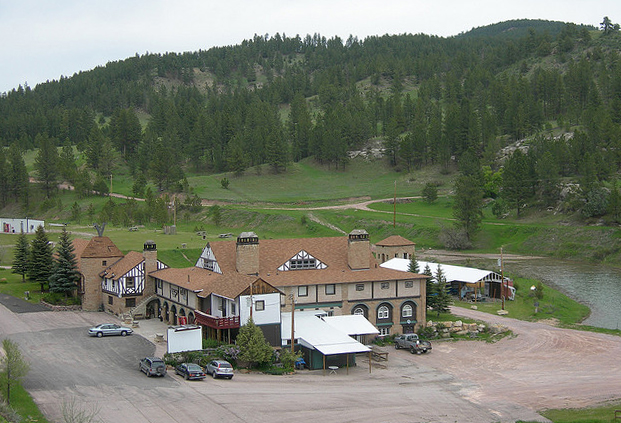About the Author
Used with permission from the website:
A photo of the author, G.B. Dobson, on horseback:
NOTE: A bit of editorial license was taken to add section titles (for the Table of Contents), some grammatical changes, and a few pieces of information added while researching Cambria and The Flying V on the internet. Basically, the same article and history – with a few enhancements!
__________________________________
History of Cambria, Wyoming
Cambria, Wyoming (8 miles north of Newcastle, WY) was established in 1887 as a company coal mine owned by the Cambria Fuel Company, a subsidiary of Kilpatrick Brothers and Collins, contractors to the Chicago, Burlington & Quincy Railroad. Construction of the railroad had come to a halt near Alliance, Nebraska, due to the high cost of providing coal for the locomotives from the eastern United States. With the discovery of a reliable and local source of coal in Little Oil Creek Canyon (renamed Cambria Canyon), railroad construction was able to resume with a spur line reaching the canyon in 1889. In June of 1889, land patents for initial properties were issued to Joseph M Kilpatrick and Robert J. Kilpatrick.
__________________________________
Population & Growth
In 1895 the population of Cambria was 329 – and by 1904 the population had grown to 1,400. At its height, the town of Cambria had more than 150 houses, two churches, three fraternal orders (Improved Order of Redmen, Odd Fellows, and Knights of Pythias), a two story hotel, an opera house, a concert band, and a large commissary at which Company script could be used.
__________________________________
Company Script
In addition to script, smaller denominations would be issued by the company in the form of “coins” known as “clacker” – so called from the sound that the cheap coins made.
Coal companies during this era often charged higher prices at their own commissary (grocery store) and made money again when the script was used at a non-company store and later redeemed only at a discount from face value.
__________________________________
Weston County Sheriff
To the right is a photo of Billy Miller delivering milk from a wagon in Cambria.
Billy Miller was later elected as sheriff of Weston County and was killed at the “Battle of Lightning Creek” in 1903. While some may dispute the claim – that battle is actually The Last Battle of the Sioux.
(The dispute probably lies with the courts decision that the Sioux were only defending themselves – therefore not a battle. Regardless… shots were fired, bullets were flying and people were dying.)
__________________________________
A Company Town
The Cambria Fuel Company also converted the coal it mined into coke, using 74 separate ovens. An electric system was installed, powered by 1,800 hp. steam engines. The fireboxes for the boilers were emptied by an electrically powered conveyor system. Thus, the boilers could be operated by only one employee. Water for the town came from a 2,345 deep well which used compressed air to raise the water. Horses, mules, and other provisions were supplied by a Kilpatrick Brothers & Collins owned ranch.
By 1904, the mine employed over 500 men. An initial condition of employment was the employees would apply for homestead on lands adjacent to Company owned properties and upon the patent being issued, convey the property to the Company. This was probably illegal, but apparently nothing was done by the government.
As a Company owned town, there were no saloons, dance halls or other places of resort for lonely miners. This probably contributed to the growth of Newcastle (to the south) which had such attractions.
__________________________________
The Cambria School
Because the school house was located on top of Cambria Canyon, all students had to climb up some 365 steps to get to the school each day — then back down after school. The teacher climbed the same steps, as well as parents or other visitors to the school.
Below are pictures of the school, circa 1910, and the flight of wooden stairs traversed each day, up and down.
__________________________________
Cambria Churches
The first Catholic services in Cambria were conducted in 1891 on a periodic basis by the Reverend P. Cassidy from Hot Springs, South Dakota. The church building was constructed in 1903 under the leadership of the Reverend P. J. Lynch. The land the building was constructed on was leased from the Cambria Fuel Company under a 99 year lease at a cost $2,000. Initially, church services could be best desribed as sporatic. However regardless of denomination, when a visiting priest or minister conducted services many would attend.
The Right Reverend Ethelbert Talbot, Episcopal Bishop of Wyoming, later recalled a pastoral visit to Cambria. He noted that many of the miners were Italian. Nevertheless, on the following day leaving town on the train, one of the miners whose command of English was less that perfect recognized the bishop from the services the night before. The miner felt compelled to complement the bishop:
“Ah, you ze cardinal. I hear you talk last night. Damn pretty church! Damn big crowd! Damn good talk!”
Excerpt from, “My People of the Plains” by Ethelbert Talbot, publisher Harper & Brothers, New York, 1906.
__________________________________
Entertainment in Cambria
For the most part, entertainment in the coal camps was self-created. Therefore, most coal camps had a band made up from the miners and workers. Although dances might be held, there was a distinct shortage of women.
Frank Mondell in his memoirs, recalled a Christmas square dance at Cambria in 1887 at which there was only seven women. To have enough dancing partners, an individual identified as “Big Mike” filled in wearing a red bandana.
Music was provided by a band consisting of a harmonica and a fiddle.
__________________________________
Cambria Fraternal Lodges
Social life was filled by fraternal lodges. In Cambria there were three lodges, the Improved Order of Redmen, Odd Fellows, and the Knights of Pythias. Seated in the front row are the installing officers representing the Knights of Pythias Grand Lodge.
Included among the installing officers from Deadwood Lodge No. 5, K. of P., are Edward McDonald, Solomon Star, J. F. Edmonds, Robert Brown, and James Harris. The members of the Lodge are outside the public hall. The Hall housed, in addition to a lodge and meeting room on the second floor, a gymnasium and a pool hall.
McDonald, Secretary of the Deadwood Lodge, was engaged in the saddlery business and served as mayor of Deadwood City for two terms and as Sheriff of Lawrence County, Dakota Territory. It is alleged that during his term as sheriff he never had to draw his gun. He did however, have to leap off a speeding train to catch on foot an escaping lunatic.
Solomon Star was not only active in the Knights of Pythias, but was a 33rd Degree Mason and served as the first Grand Master of the Grand Lodge of Montana. Additionally, he was the first Exalted Ruler of the Deadwood Elks Lodge and was a member of the Ancient Order of United Workmen.
The Ancient Order was founded in 1868 and provided to the fraternity of lodges life insurance benefits to its members. By 1895, the Order had more than 318,000 members. By 1948, the insurance became the dominating factor in the operation of the Order, and so the Order changed its name and became an insurance company – in name as well as fact. Solomon was a partner of Seth Bullock in Deadwood and served for twenty years as Clerk of Courts of Lawrence County. He also served as mayor of Deadwood City.
J. F. Edmonds at the time of the photo was a Past Grand Chancellor and Past Grand Prelate of the Dakota Territory Grand Lodge of the Knights of Pythias. A year later in 1894, Delaware Tribe No. 3 of the Improved Order of Redmen was instituted.
__________________________________
The End of Coal & Cambria
By 1928, the coal deposits were no longer sufficient to economically mine. In February 1928, the announcement was made that the Cambria Fuel Company operation would close by April of that year. On March 15, the mine whistle blew for the last time and a formal closing ceremony was conducted on April 28. By the time of its abandonment, some 12,000,000 tons of coal had been mined at Cambria.
After the coal mine closed, buildings were sold and some were scavenged for lumber. As illustrated by photos from Russell Lee in the next section, the town fell rapidly fell into ruin. On December 31, 1928, the post office which had been established in 1890 was discontinued. Today, little is visible except for street patterns from days gone by. The majority of the Cambria town site now resides on privately owned property and trespassing is discouraged.
__________________________________
Historical Photographer
The photos taken below in the next section (Remembering Cambria) are by Russell Lee (1903-1986) for the Farm Security Administration, a New Deal program under President Franklin D. Roosevelt.
Russell Lee worked as a part of the Historical Section of the Farm Security Administration under the creative supervision of Roy Stryker (1893-1975). Roy Stryker, originally a Columbia University economist, was described by one photographer who worked for Roy as:
“As an archivist, he didn’t give a damn about a picture at the time it was made. He was interested in what it would mean twenty years later… He was saving pictures for a record of the past.”
During the period 1935 to 1942, the Historical Section created 77,000 photographs for the department. Later on, Russell Lee became the first professor of photography at the University of Texas, Austin.
__________________________________
Remembering Cambria in Photos
The Burlington Railroad received permission from the Interstate Commerce Commission to abandon the line to Newcastle in 1929. For comparison’s sake, note the Cambria Hotel photo above with the 1890 view of the Cambria Fuel Company photo below. (The Cambria Hotel is in the far left center in the below photo.)
One last look, circa 1940, looking “Up Canyon” into Cambria:
__________________________________
Then and Now: The Flying V
Unbeknownst at the time of what the future held, in 1923 the Cambria Fuel Company started construction of a resort facility to be known as the “Cambria Casino Park”, which was completed in 1928 for a cost of more than $250,000 at that time. (Today it would cost a sight more to build!)
The term “casino” had no relation to gambling at the time. It referred to an attractive place for the entertainment of mostly local residents. (Vegas style casinos didn’t come about until the 1940’s and 50’s – almost 20 years later.)
With the closing of the mine, the new facility was eventually sold to an entity called the “Cambria Park Commissioners”. They managed and ran the property for about four years and then they leased out the property to various groups and organizations. During World War II, the facility was unable to pay its taxes and was sold for taxes owed. It has been leased at various times to the Fying V Ranch which had cattle operations in the area and to the Pentecostal Church as a bible camp. It has subsequently been operated as a dude ranch and recently as a bed and breakfast called The Flying V Cambria Inn.
UPDATE: The Flying V Lodge, as it is known today, is owned and operated by Larry & Twylla Napolitano. Offering an old world atmosphere for a Bed and Breakfast getaway located on the edge of the Black Hills, The Flying V especially caters to Hunter’s seeking a Hunter’s Harbor before and after the hunt. Hunter’s really appreciate that The Flying V can process any game brought in for processing, packaging, freezing, storage, and shipping. Above is a photo of The Flying V Lodge as it looks today.
__________________________________





